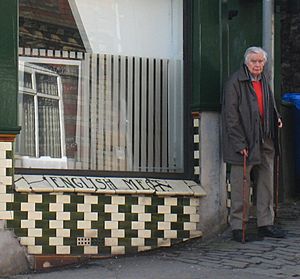Richard Gregory facts for kids
Quick facts for kids
Richard Gregory
|
|
|---|---|

Gregory outside the café on St Michael's Hill, Bristol, which inspired his (re-)discovery of the "café wall illusion", February 2010
|
|
| Born |
Richard Langton Gregory
24 July 1923 London, England
|
| Died | 17 May 2010 (aged 86) Bristol, England
|
| Spouse(s) |
Margaret Hope Pattison Muir
(m. 1953; div. 1966)Freja Mary Balchin
(m. 1967; div. 1976) |
| Partner(s) | Priscilla Heard |
| Children | 2 |
| Awards | Michael Faraday Prize (1992) |
| Scientific career | |
| Fields | Psychology, neuropsychology |
| Institutions | University of Bristol |
Richard Langton Gregory (24 July 1923 – 17 May 2010) was a famous British psychologist. A psychologist studies how the mind works and how it affects behavior. He was also a Professor of Neuropsychology at the University of Bristol. Neuropsychology looks at how the brain affects our thoughts and actions.
Contents
Life and Early Career
Richard Gregory was born in London, England. His father, Christopher Clive Langton Gregory, was the first director of the University of London Observatory.
During World War II, Richard Gregory served in the Royal Air Force (RAF). He worked in the Signals branch. After the war, he received a scholarship from the RAF. This allowed him to study at Downing College, Cambridge. He later became an Honorary Fellow there in 1999.
In 1967, Richard Gregory helped start a new department. It was called the Department of Machine Intelligence and Perception. This was at the University of Edinburgh. It was an early step towards what we now call Artificial Intelligence. He also started a science journal called Perception in 1972. This journal focused on how we see and understand the world.
Richard Gregory worked with another scientist, W. E. Hick. They studied how quickly people can gain information. Gregory was the only person to finish Hick's experiment!
Bringing Science to Everyone
In 1981, Gregory created something special. He founded The Exploratory in Bristol. This was the first hands-on science center in the UK. It let people explore science by doing experiments themselves. In 1989, he also visited the Exploratorium in San Francisco, California. This was a similar science education center.
Gregory was very interested in optical illusions. These are tricks of the eye that show us how our brains interpret what we see. He believed illusions could teach us a lot about human perception. He wrote many books, including Eye and Brain and Mind in Science. He also loved making puns, which are clever word jokes.
Richard Gregory passed away on May 17, 2010, in Bristol. He was surrounded by his family and friends.
Lectures and Talks
In 1967, he gave the famous Royal Institution Christmas Lectures. These lectures are for young people. His series was called The Intelligent Eye. He also appeared on many science TV shows. He helped people around the world understand science better.
Understanding How We See
Richard Gregory's biggest contribution was to cognitive psychology. This field studies how we think, learn, and remember. He developed the idea that "Perception as hypotheses" helps us see the world.
This idea came from earlier scientists. Hermann von Helmholtz (1821–1894) and his student Wilhelm Wundt (1832–1920) were key figures. They studied how our senses work, especially sight and hearing.
Gregory explained that Helmholtz realized something important. Seeing is not just passively taking in information. It's an active process. Our brains use memory and other internal processes to make sense of what we see.
Gregory used a great analogy to explain this. He said our brain builds a picture of the world. This is like how scientists build their understanding of the world. Scientists use a process of making guesses (hypotheses) and testing them. Our brains do something similar, but much faster. They constantly make "guesses" about what we are seeing.
Gregory's ideas were different from some other scientists. For example, J. J. Gibson believed we see things directly. But Gregory argued that our brains combine what we see with what we already know. He used optical illusions to show this. Illusions like the illusory contours in the Kanizsa triangle prove his point. Our brains "fill in" missing information to create a complete picture.
Key Books
Richard Gregory wrote many important books. Here are some of his most well-known:
- Eye and Brain: The Psychology of Seeing (1966)
- The Intelligent Eye (1970)
- Mind in Science: A History of Explanations of Psychology and Physics (1981)
- Seeing Through Illusions (2009)
Family
Richard Gregory had two children, Mark and Romilly Gregory. He also had two grandchildren, Luutsche Ozinga and Kiran Rogers. His long-term partner was Priscilla Heard.
See also


